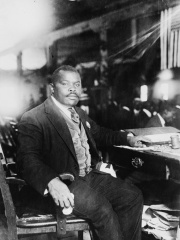
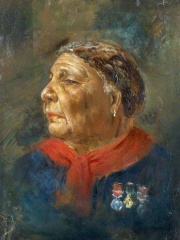

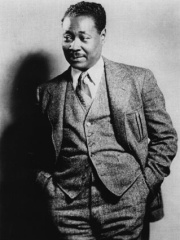
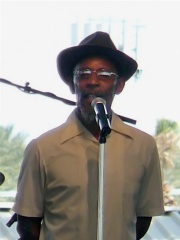
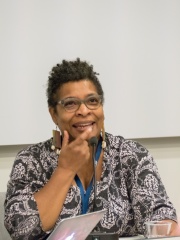
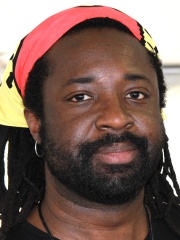
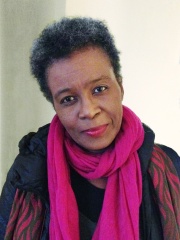
The Most Famous
WRITERS from Jamaica
Top 9
The following people are considered by Pantheon to be the most legendary Jamaican Writers of all time. This list of famous Jamaican Writers is sorted by HPI (Historical Popularity Index), a metric that aggregates information on a biography's online popularity.

1. Marcus Garvey (1887 - 1940)
With an HPI of 65.47, Marcus Garvey is the most famous Jamaican Writer. His biography has been translated into 54 different languages on wikipedia.
Marcus Mosiah Garvey Jr. (17 August 1887 – 10 June 1940) was a Jamaican political activist. He was the founder and first President-General of the Universal Negro Improvement Association and African Communities League (UNIA-ACL, commonly known as UNIA), through which he declared himself Provisional President of Africa. Garvey was ideologically a black nationalist and Pan-Africanist. His ideas came to be known as Garveyism. Garvey was born into a moderately prosperous Afro-Jamaican family in Saint Ann's Bay and was apprenticed into the print trade as a teenager. Working in Kingston, he became involved in trade unionism. He later lived briefly in Costa Rica, Panama, and England. On returning to Jamaica, he founded the UNIA in 1914. In 1916, he moved to the United States and established a UNIA branch in New York City's Harlem district. Emphasising unity between Africans and the African diaspora, he campaigned for an end to European colonial rule in Africa and advocated the political unification of the continent. He envisioned a unified Africa as a one-party state, governed by himself, that would enact laws to ensure black racial purity. Although he never visited the continent, he was committed to the Back-to-Africa movement, arguing that part of the diaspora should migrate there. Garveyist ideas became increasingly popular, and the UNIA grew in membership. His black separatist views—and his relationship with white racists like the Ku Klux Klan (KKK) in the interest of advancing their shared goal of racial separatism—caused a division between Garvey and other prominent African-American civil rights activists such as W. E. B. Du Bois, who promoted racial integration. Believing that black people needed to be financially independent from white-dominated societies, Garvey launched various businesses in the U.S., including the Negro Factories Corporation and Negro World newspaper. In 1919, he became President of the Black Star Line shipping and passenger company, designed to forge a link between North America and Africa and facilitate African-American migration to Liberia. In 1923 Garvey was convicted of mail fraud for selling the company's stock, and was imprisoned in the United States Penitentiary, Atlanta for nearly two years. Garvey blamed Jews and Catholics, claiming that they were prejudiced against him because of his links to the KKK. His sentence was commuted by U.S. president Calvin Coolidge and he was deported to Jamaica in 1927. Settling in Kingston with his wife Amy Jacques, Garvey established the People's Political Party in 1929, briefly serving as a city councillor. With the UNIA in increasing financial difficulty, he relocated to London in 1935, where his anti-socialist stance distanced him from many of the city's black activists. He died there in 1940, and in 1964 his body was returned to Jamaica for reburial in Kingston's National Heroes Park. Garvey was a controversial figure. Some in the African diasporic community regarded him as a pretentious demagogue, and were highly critical of his collaboration with white supremacists, his violent rhetoric, and his prejudice against mixed-race people and Jews. He received praise for encouraging a sense of pride and self-worth among Africans and the African diaspora amid widespread poverty, discrimination and colonialism. In Jamaica, he is recognized as a national hero, the first person to be recognized as such. His ideas exerted a considerable influence on such movements as Rastafari, the Nation of Islam and the Black Power Movement.

2. Mary Seacole (1805 - 1881)
With an HPI of 58.17, Mary Seacole is the 2nd most famous Jamaican Writer. Her biography has been translated into 34 different languages.
Mary Jane Seacole (née Grant; 23 November 1805 – 14 May 1881) was a Jamaican nurse and businesswoman. She was famous for her nursing work during the Crimean War and for publishing the first autobiography written by a black woman in Britain. Seacole was born in Kingston, Jamaica, to a Creole mother who ran a boarding house and had herbalist skills as a "doctress". In 1990, Seacole was (posthumously) awarded the Jamaican Order of Merit. In 2004, she was voted the greatest Black Briton in a survey conducted in 2003 by the black heritage website Every Generation. Seacole went to the Crimean War in 1855 with the plan of setting up the "British Hotel", as "a mess-table and comfortable quarters for sick and convalescent officers". However, chef Alexis Soyer told her that officers did not need overnight accommodation, so she instead made it into a restaurant/bar/catering service. It proved to be very popular and she and her business partner, a relative of her late husband, did well on it until the end of the war. Her 1857 memoir, Adventures of Mrs Seacole in Many Lands, includes three chapters of the food she served and the encounters she had with officers, some of them high-ranking, and including the commander of the Turkish forces. Mrs Seacole missed the first three major battles of the war, as she was busy in London attending to her gold investments—she had arrived from Panama, where she had provided services for prospectors going overland to and from the California Gold Rush. She gave assistance at the battlefield on three later battles, going out to attend to the fallen after serving wine and sandwiches to spectators. In her memoir, Mrs Seacole described several attempts she made to join that team; however, she did not start her informal inquiries until after both Florence Nightingale and her initial team, and a later one, had left. When Seacole left, it was with the plan of joining her business partner and starting their business. She travelled with two Black employees, her maid Mary, and a porter, Mac. She was largely forgotten for almost a century after her death. Her autobiography, Wonderful Adventures of Mrs. Seacole in Many Lands (1857), was the first autobiography written by a Black woman in Britain. The erection of a statue of her at St Thomas' Hospital, London, on 30 June 2016, describing her as a "pioneer", generated some controversy and opposition, especially among those concerned with Nightingale's legacy.

3. Leonard Howell (1898 - 1981)
With an HPI of 54.29, Leonard Howell is the 3rd most famous Jamaican Writer. His biography has been translated into 18 different languages.
Leonard Percival Howell (16 June 1898 – 23 January 1981), also known as The Gong or G. G. Maragh (for Gangun Guru), was a Jamaican religious figure. According to his biographer Hélène Lee, Howell was born into an Anglican family. He was one of the first preachers of the Rastafari movement (along with Joseph Hibbert and Archibald Dunkley), and is known by many as The First Rasta. Born in May Crawle River on 16 June 1898, Howell left Jamaica as a youth, traveling to many places, including Panama and New York, and returned in 1932. He began preaching in 1933 about what he considered the symbolic portent for the African diaspora—the crowning of Ras Tafari Makonnen as Emperor Haile Selassie I of Ethiopia. His preaching asserted that Haile Selassie was the "Messiah returned to earth", and he published a book called The Promised Key. Although this resulted in his being arrested, tried for sedition, and imprisoned for two years, the Rastafari movement grew. Over the following years, Howell came into conflict with all the establishment authorities in Jamaica: the planters, the trade unions, established churches, police, and colonial authorities. Howell was seen as a threat largely due to the anti-colonial message of the Rastafarian movement, which he was perpetuating along with the sermons promoting the idea of a positive black racial identity. Local ruling elites were uneasy with Howell’s popular call for black people to take a stand. Colonial authorities hoped to quell Howell’s growing movement early so as to snuff out support early on. As his following grew, the threat of Howell's core beliefs in the power of black people to overcome white oppression, and his movement, expanded to become an international concern given his strong messages of black liberation and Pan-Africanism that resonated with blacks across the globe. He formed a town or commune called Pinnacle in Saint Catherine Parish that became famous as a place for Rastafari. This movement prospered, and today the Rastafari faith exists worldwide. Unlike many Rastafari, Howell never wore dreadlocks. Leonard Howell died in Kingston, Jamaica, on 23 January 1981 after suffering a vicious attack months earlier where he was slashed in the face and beaten badly at the age of 83 in Tredegar Park, St. Catherine not far from Pinnacle. Although Leonard P. Howell suffered much abuse for the foundation of Rastafari, his legacy as a perceived true hero and leader in anti-colonialism took root throughout Jamaica and the Caribbean and eventually globally. Ironically, the same government who sought his continual persecution has in 2022 awarded L.P. Howell or 'Gong' with an Order of Distinction.

4. Claude McKay (1889 - 1948)
With an HPI of 53.52, Claude McKay is the 4th most famous Jamaican Writer. His biography has been translated into 21 different languages.
Festus Claudius "Claude" McKay (September 15, 1890 – May 22, 1948) was a Jamaican-American writer and poet. He was a central figure in the Harlem Renaissance. Born in Jamaica, McKay first travelled to the United States to attend college, and encountered W. E. B. Du Bois's The Souls of Black Folk which stimulated McKay's interest in political involvement. He moved to New York City in 1914 and, in 1919, he wrote "If We Must Die", one of his best known works, a widely reprinted sonnet responding to the wave of white-on-black race riots and lynchings following the conclusion of the First World War. McKay also wrote five novels, Home to Harlem (1928), a best-seller that won the Harmon Gold Award for Literature, Banjo (1929), Banana Bottom (1933), Harlem Glory (written in 1938–1940, published in 1990), Amiable With Big Teeth: A Novel of the Love Affair Between the Communists and the Poor Black Sheep of Harlem (written in 1941, published in 2017), and a novella, Romance in Marseille (written in 1933, published in 2020). Besides these novels and four published collections of poetry, McKay also authored a collection of short stories, Gingertown (1932); two autobiographical books, A Long Way from Home (1937) and My Green Hills of Jamaica (published posthumously in 1979); and Harlem: Negro Metropolis (1940), consisting of eleven essays on the contemporary social and political history of Harlem and Manhattan, concerned especially with political, social and labor organizing. His 1922 poetry collection, Harlem Shadows, was among the first books published during the Harlem Renaissance and his novel Home To Harlem was a watershed contribution to its fiction. His Selected Poems was published posthumously, in 1953. His Complete Poems (2004) includes almost ninety pages of poetry written between 1923 and the late 1940s, most of it previously unpublished, a crucial addition to his poetic oeuvre. McKay was introduced to British Fabian socialism in his teens by his elder brother and tutor Uriah Theodore, and after moving to the United States in his early 20s he encountered the American socialist left in the work of W. E. B. Du Bois and through his membership in the Industrial Workers of the World (IWW) — the only American left-labor organization of the era that was totally open to Negro members (as he comments), continuing the tradition of the populist People's Party of the previous generation. In the course of the teens he became acquainted with the writings of Marx and the programs of a variety of activists. As a co-editor of The Liberator magazine, he came into conflict with its hard-line Leninist doctrinaire editor Mike Gold, a contention which contributed to his leaving the magazine. In 1922–1923, he traveled to the Soviet Union to attend a Congress of the International, there encountering his friend Liberator publisher Max Eastman, a delegate to the Congress. In Russia, McKay was widely feted by the Communist Party. While there, he worked with a Russian writer to produce two books which were published in Russian, The Negroes of America (1923), a critical examination of American black-white racism from a Marxist class-conflict perspective, and Trial By Lynching (1925); translations of these books back into English appeared in 1979 and 1977 respectively; McKay's original English texts are apparently lost. In the Soviet Union, McKay eventually concluded that, as he says of a character in Harlem Glory, he "saw what he was shown." Realizing that he was being manipulated and used by the Party apparatus, and responding critically to the authoritarian bent of the Soviet regime, he left for Western Europe in 1923, first for Hamburg, then Paris, then the South of France, Barcelona and Morocco. After his return to Harlem in 1934, he found himself in frequent contention with the Stalinist New York City Communist Party which sought to dominate the left politics and writing community of the decade. His prose masterpiece, A Long Way From Home, was attacked in the New York City press on doctrinaire Stalinist grounds. This conflict is reflected in Harlem: Negro Metropolis and satirized in Amiable With Big Teeth. His sonnet sequence, "The Cycle," published posthumously in the Complete Poems, deals at length with McKay's confrontation with the left political machine of the time. Increasingly ill in the mid-40s, he was rescued from extremely impoverished circumstances by a Catholic Worker friend and installed in a communal living situation; later in the decade, he converted to Catholicism and died in 1948.
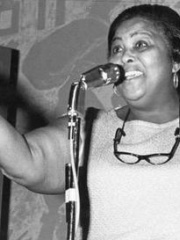
5. Louise Bennett-Coverley (1919 - 2006)
With an HPI of 53.18, Louise Bennett-Coverley is the 5th most famous Jamaican Writer. Her biography has been translated into 16 different languages.
Louise Simone Bennett-Coverley or Miss Lou (7 September 1919 – 26 July 2006), was a Jamaican poet, folklorist, actress, writer, and educator. Writing and performing her poems in Jamaican Patois or Creole, Bennett worked to preserve the practice of presenting poetry, folk songs and stories in patois ("nation language"), establishing the validity of local languages for literary expression.

6. Linton Kwesi Johnson (b. 1952)
With an HPI of 52.68, Linton Kwesi Johnson is the 6th most famous Jamaican Writer. His biography has been translated into 20 different languages.
Linton Kwesi Johnson CD (born 24 August 1952), also known as LKJ, is a Jamaica-born, British-based dub poet and activist. In 2002, he became the second living poet, and the only black one, to be published in the Penguin Modern Classics series. His performance poetry involves the recitation of his own verse in Jamaican patois over dub-reggae, usually written in collaboration with reggae producer/artist Dennis Bovell.

7. Nalo Hopkinson (b. 1960)
With an HPI of 42.48, Nalo Hopkinson is the 7th most famous Jamaican Writer. Her biography has been translated into 20 different languages.
Nalo Hopkinson (born 20 December 1960) is a Jamaican-born Canadian speculative fiction writer and editor. Her novels – Brown Girl in the Ring (1998), Midnight Robber (2000), The Salt Roads (2003), The New Moon's Arms (2007) – and short stories such as those in her collection Skin Folk (2001) often draw on Caribbean history and language, and its traditions of oral and written storytelling. Hopkinson has edited two fiction anthologies: Whispers from the Cotton Tree Root: Caribbean Fabulist Fiction and Mojo: Conjure Stories. She was the co-editor with Uppinder Mehan of the 2004 anthology So Long Been Dreaming: Postcolonial Visions of the Future, and with Geoff Ryman co-edited Tesseracts 9. Hopkinson defended George Elliott Clarke's novel Whylah Falls on the CBC's Canada Reads 2002. She was the curator of Six Impossible Things, an audio series of Canadian fantastical fiction on CBC Radio One. As of 2021, she lives and teaches in Vancouver, British Columbia. In 2020, Hopkinson was named the 37th Damon Knight Grand Master, in recognition of "lifetime achievement in science fiction and/or fantasy".

8. Marlon James (b. 1970)
With an HPI of 41.89, Marlon James is the 8th most famous Jamaican Writer. His biography has been translated into 25 different languages.
Marlon James (born 24 November 1970) is a Jamaican writer. He is the author of five novels: John Crow's Devil (2005), The Book of Night Women (2009), A Brief History of Seven Killings (2014), which won him the 2015 Man Booker Prize, Black Leopard, Red Wolf (2019), and Moon Witch, Spider King (2022). He wrote the limited series Get Millie Black. Now living in Minneapolis, Minnesota, James teaches literature at Macalester College in Saint Paul, Minnesota. He is also a faculty lecturer at St. Francis College's Low Residency MFA in Creative Writing.

9. Claudia Rankine (b. 1963)
With an HPI of 40.68, Claudia Rankine is the 9th most famous Jamaican Writer. Her biography has been translated into 15 different languages.
Claudia Rankine (; born September 4, 1963) is a Jamaican-American poet, essayist, playwright, and the editor of several anthologies. She is the author of five volumes of poetry, two plays and various essays. Her book of poetry, Citizen: An American Lyric, won the 2014 Los Angeles Times Book Award, the 2015 National Book Critics Circle Award in Poetry (the first book in the award's history to be nominated in both poetry and criticism), the 2015 Forward Prize for Best Collection, the 2015 Hurston/Wright Legacy Award in Poetry, the 2015 NAACP Image Award in poetry, the 2015 PEN Open Book Award, the 2015 PEN American Center USA Literary Award, the 2015 PEN Oakland-Josephine Miles Literary Award, and the 2015 VIDA Literary Award. Citizen was also a finalist for the 2014 National Book Award and the 2015 T. S. Eliot Prize. It is the only poetry book to be a New York Times bestseller in the nonfiction category. Rankine's numerous awards and honors include the 2014 Morton Dauwen Zabel Award from the American Academy of Arts and Letters, the 2014 Jackson Poetry Prize, and the 2014 Lannan Foundation Literary Award. In 2005, she was awarded the Academy Fellowship for distinguished poetic achievement by the Academy of American Poets. In 2013, she was elected a Chancellor of the Academy of American Poets. She is a 2016 United States Artist Zell Fellow and a 2016 MacArthur Fellow. In 2020, she was elected a Fellow of the American Academy of Arts and Sciences. Rankine has taught at Pomona College and was the Frederick Iseman Professor of Poetry at Yale University. In 2021, she joined the New York University Creative Writing Program as a Professor.
People
Pantheon has 9 people classified as Jamaican writers born between 1805 and 1970. Of these 9, 4 (44.44%) of them are still alive today. The most famous living Jamaican writers include Linton Kwesi Johnson, Nalo Hopkinson, and Marlon James. The most famous deceased Jamaican writers include Marcus Garvey, Mary Seacole, and Leonard Howell.
Living Jamaican Writers
Go to all RankingsLinton Kwesi Johnson
1952 - Present
HPI: 52.68
Nalo Hopkinson
1960 - Present
HPI: 42.48
Marlon James
1970 - Present
HPI: 41.89
Claudia Rankine
1963 - Present
HPI: 40.68
Deceased Jamaican Writers
Go to all RankingsMarcus Garvey
1887 - 1940
HPI: 65.47
Mary Seacole
1805 - 1881
HPI: 58.17
Leonard Howell
1898 - 1981
HPI: 54.29
Claude McKay
1889 - 1948
HPI: 53.52
Louise Bennett-Coverley
1919 - 2006
HPI: 53.18
Overlapping Lives
Which Writers were alive at the same time? This visualization shows the lifespans of the 5 most globally memorable Writers since 1700.

